Spitfire Update Sets
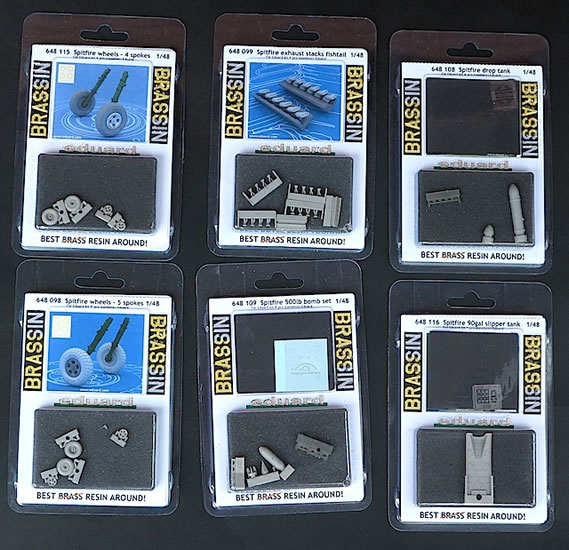
Eduard BRASSIN, 1/48 scale
S u m m a r y : |
Catalogue Number |
Eduard BRASSIN Item Nos.:
648 098 Spitfire wheels – 5 spokes
648 099 Spitfire exhaust stacks fishtail
648 108 Spitfire drop tank
648 109 Spitfire 500lb bomb
648 115 Spitfire wheels – 4 spokes
648 116 Spitfire 90 gallon slipper tank.
|
Contents and Media |
648 098 and 648 115: four grey resin parts, die cut tape masks
648 099: 18 grey resin parts
648 108: two grey resin parts, one small photo-etched fret
648 109: six grey resin parts, one small photo-etched fret, one small decal sheet
648 116: one grey resin part, one small photo-etched fret
All sets include small fold-out instruction sheets. |
Scale |
1/48 |
Price: |
648 098 USD $6.76
648 099 USD $6.76
648 108 USD $6.76
648 109 USD $8.46
648 115 USD $6.76
648 116 USD $8.46
plus shipping, all available online from Eduard’s website and specialist hobby retailers worldwide |
Review Type |
First Look |
Advantages: |
Well cast; generally accurate; wheels and exhausts offer more refined detail than their equivalent parts in Eduard’s 1/48 Spitfire Mk.IX kits; drop tanks and bomb not offered in Eduard kits ‘Dunlop’ misspelt on the sidewalls of the tyres in the five spoke wheel set. |
Disadvantages: |
‘Dunlop’ misspelt on the sidewalls of the tyres (probably intentionally) in the five spoke wheel set |
Recommendation: |
All of these Brassin sets offer parts that are either finer in detail than their Eduard kit equivalents, or are not included in the kit. You will need to be judicious in choosing which sets to buy for your model, because not all are applicable to every Mk.IX. But used appropriately, these sets will improve the look of your Eduard (or other manufacturer’s) Spitfire, and can be highly recommended. |
Reviewed by Brad Fallen

Eduard's 1/48 BRASSIN Spitfire Accessories are available online from Squadron.com
Since launching its 1/48 Spitfire Mk.IX range in April 2013, Eduard has released a number of complementary Brassin sets for adding further detail to these kits. Some, such as the cockpit and engine sets, are mini-kits in their own right and aimed squarely at experienced modellers. However most of the sets provide simple enhancements or drop-fit replacements, and will be generally straightforward to assemble and/or install. The six sets reviewed here fall into this category, and – although marked as ‘for Eduard kit’ – will also be suitable to use on appropriate Spitfire kits from other manufacturers.
Five Spoke and Four Spoke Wheels
Previously included in Eduard’s Royal Class Spitfire Mk.IX kit, these sets give modellers wheels with the two main hub types seen on Mk.IXs. While conventional wisdom says that five spoke wheels were fitted to early Mk.IXs and four spoke wheels to later Mk. IXs, there were variations and you should check your references for the Spitfire you are modelling.
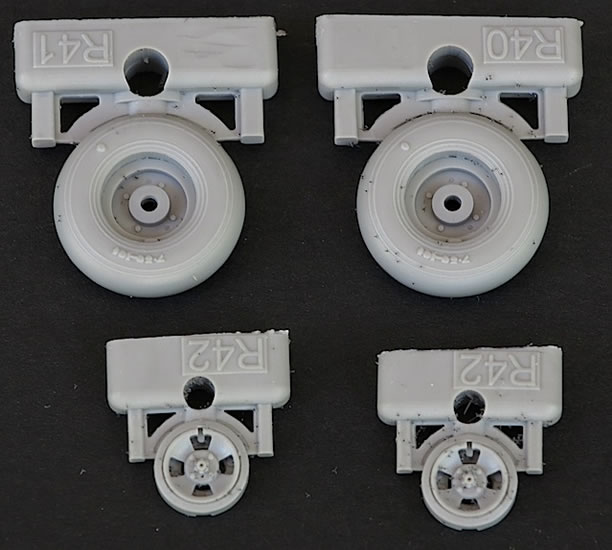
Both sets contain four resin pieces – two tyres and two hubs – attached to their casting blocks by cleverly engineered rebates that will minimise cutting and cleanup time. The tyres in the four spoke set are smooth with raised sidewall details, while those in the five spoke set have what appears to be a z-block tread. The latter also carry the now well-known misspelled ‘Dunlop’ logo on their sidewalls, which will be easier to remove completely than attempt to correct. Again, consult your references for the appropriateness of these tyre types for the aircraft you are modelling.
In both sets, the outer hubs are cast as separate parts to make painting easier; Eduard also provides pre-cut masks to assist with this process.

Are the Brassin wheels better than the plastic wheels in Eduard’s Spitfire kits? The kit tyres are moulded in two halves that need to be glued together and then cleaned up, although this should be fairly easy to do as the tyres have no tread or other surface detail to damage. Four and five spoke hubs are included, and these are moulded separately from the tyres to help with painting. The plastic hubs have good detail, but it’s not as crisp as on their Brassin counterparts. Ultimately the choice is up to you – the kit wheels are accurate and very acceptable, while the Brassin wheels have the advantage of finer detail and single piece tyres (but noting that the tyres in the five spoke set have a spelling error on their sidewalls).
Drop Tanks
These two sets offer items that are not included in Eduard’s Profipack and Weekend Edition Spitfire Mk.IX kits. The Brassin 90 gallon slipper tank was included in the Royal Class boxing, and is a lovely example of resin casting. The single piece tank may be slightly trickier to remove from its casting block than the tyres, but with careful fitting and painting it should look really good. Additional details are provided via a small fret of photo-etched parts.
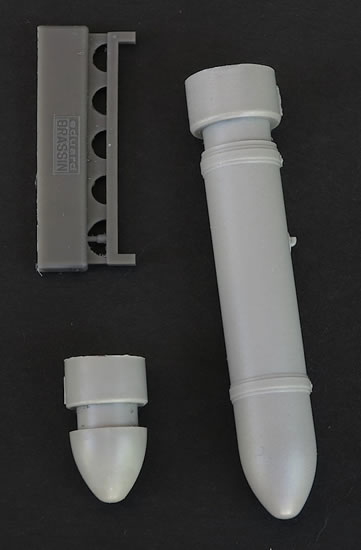
The same 90 gallon tank was used on a number of Spitfire versions earlier than the Mk.IX, but the tank’s complex curves mean that the Brassin part may require some fettling in order to fit kits of these aircraft.
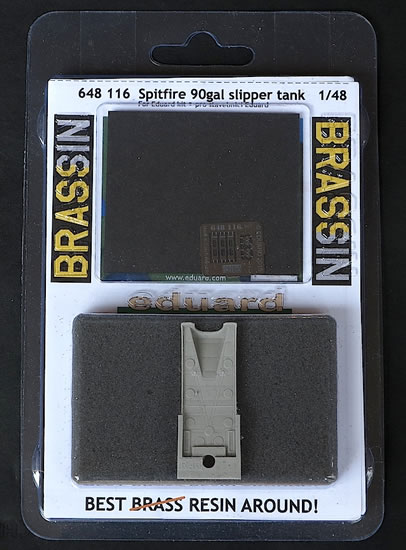
The 90 gallon drop tank is a slightly more complex set than the slipper tank, consisting of three resin pieces – front and rear body sections and a mounting rail – and a quite delicate looking photo etched sway brace (fortunately a spare is provided). Assembly should be straightforward, but note that these streamlined tanks were only fitted to Spitfires from 1944 onwards – so if you are contemplating adding one to your model, make sure it’s a time-appropriate combination.
500 lb Bomb
Eduard’s Mk.IX kits contain parts for two 250 lb British bombs, but not for the 500 lb bomb offered in this Brassin set. This is the most complex of the sets being examined here, and is made up from six resin pieces and several tiny photo etched parts.
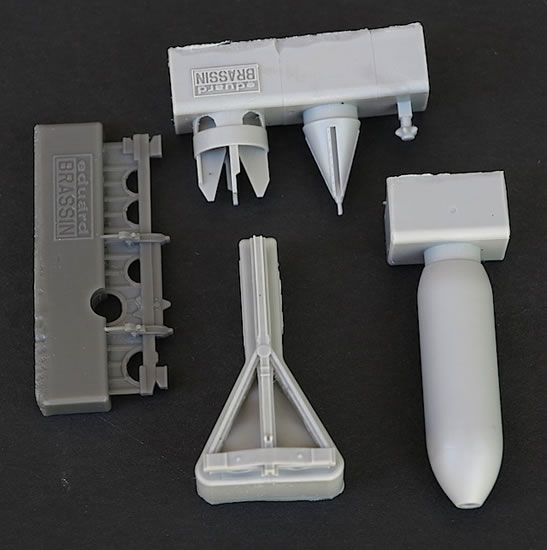
Some of the resin parts, particularly the mounting rail and the bomb crutch, look fragile and will need to be removed from their casting blocks carefully. A small decal sheet provides bomb rings and stencils for application after the bomb is assembled and painted.
Exhausts
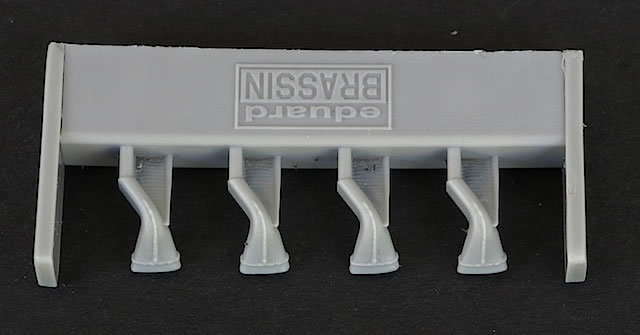
The fishtail and tubular exhausts that come with Eduard’s Spitfire kits are fine examples of injection moulding, with hollowed-out ends and delicate weld seams. Nonetheless, the resin details in the Brassin fishtail exhaust stacks set are finer still, and this set has the potential to greatly enhance your model.
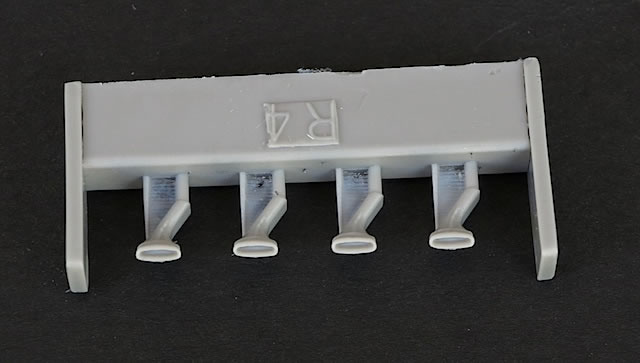
However, you will need to take care during assembly because each stack must be individually glued to a backplate, which is then attached to the model before the upper engine cowlings are cemented in place. Take your time and use a slower setting epoxy glue, rather than superglue, which might harden before you are completely happy with your alignment of the stacks. Fortunately, the clearly illustrated instructions should help considerably with this.
While you don’t need any of these Brassin sets to complete a fine-looking 1/48 Eduard Spitfire model, they all offer parts that are either finer in detail than their kit equivalents, or are not included in the kit at all. You will need to be judicious in choosing which sets to buy for your model, because not all are applicable to every Mk.IX. But used appropriately, these sets will improve the look of your Eduard (or other manufacturer’s) Spitfire, and can therefore be highly recommended.
Thanks to Eduard for the samples and images.
Review Text Copyright © 2014 by Brad Fallen
Page Created 11 June, 2014
Last updated
11 June, 2014
Back to HyperScale Main Page
Back to Reviews Page

|
